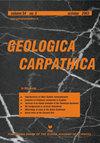Ďumbier–Prašivá高K钙碱性花岗岩岩套(低塔特拉山脉,西喀尔巴阡山脉):从地球化学和地质年代学角度深入了解其演化
IF 1.5
4区 地球科学
Q4 GEOSCIENCES, MULTIDISCIPLINARY
引用次数: 1
摘要
低太拉花岗岩主要类型Prašivá斑岩型Bt(黑云母)-花岗闪长岩和Ďumbier Bt-闪长岩的地球化学特征表明,它们起源于最初的杂化岩浆,是由非均质下地壳熔融形成的若干岩浆脉冲混合形成的。高钾钙碱性过铝质特征以及高Ba、Sr + LREE含量对应富钾基性岩的部分熔融和中水合下地壳源与角闪洞或可能的石榴石平衡,并有变质沉积和/或长英质变质岩源的不同参与。辉长岩锆石同位素年龄为360.4±2.7 Ma,反映了俯冲大陆地壳高温变质的时间,对应于现今洋太古单元内的一个初始退析过程。岩浆年龄在很大程度上重叠,Ďumbier晶长岩的年龄为353±2 Ma, Prašivá Aln(含allanite)亚型和Mnz(含monazite)亚型的年龄为352±3 Ma和351.9±2.9 Ma,表明岩浆群的连续多次侵位和自然演化趋向于更具地壳特征。下塔特拉山的岩浆活动代表了一个与马尔本文章由计算机程序翻译,如有差异,请以英文原文为准。
The Ďumbier – Prašivá high K calc-alkaline granite suite (Low Tatra Mts., Western Carpathians): Insights into their evolution from geochemistry and geochronology
The geochemistry of major Low Tatra granitic types, namely Prašivá porphyritic Bt (biotite)-granodiorite and Ďumbier Bt-tonalite, indicate their derivation from initial hybrid magmas and represent a mixture among several magma pulses formed via melting of the heterogeneous lower crust. The high K calc-alkaline peraluminous character, along with high Ba, Sr + LREE contents correspond to the partial melting of K-rich mafic and the intermediate hydrated lower crustal source in equilibrium with amphibole or possibly garnet with variable involvement of metasedimentary and/or felsic metaigneous sources. The zircon isotopic age of 360.4 ± 2.7 Ma recorded from diatexite reflects the timing of hightemperature metamorphism of subducted continental crust, and thus corresponds in an initial anatectic process within the present Tatric Unit. The magmatic ages are in the largely overlapping sequence of 353 ± 2 Ma for the Ďumbier tonalite and 352 ± 3 Ma and 351.9 ± 2.9 Ma for Prašivá Aln (allanite bearing)-subtype and Mnz (monazite bearing)-subtypes, which indicate successive multiple emplacement of magma batches and natural evolution towards their more crustal character. Magmatism in the Low Tatra Mts. represents a post-collisional plutonic system related to the slab break-off mechanism described in the close Malá Fatra crystalline basement as well. Heat from mantle upwelling and volatiles from previous subduction forced the melting of the lower crust towards K-rich mafic or intermediate lithologies, as well as during the emplacement of long-lasting melting of felsic metasedimentary crustal sources. The crystalline core of the Low Tatra Mts. is another example of composite granite pluton in the Western Carpathians, which represents a product of the multiphase Late-Variscan post-collisional setting.
求助全文
通过发布文献求助,成功后即可免费获取论文全文。
去求助
来源期刊

Geologica Carpathica
地学-地球科学综合
CiteScore
2.40
自引率
23.10%
发文量
26
审稿时长
>12 weeks
期刊介绍:
GEOLOGICA CARPATHICA covers a wide spectrum of geological disciplines including geodynamics, tectonics and structural geology, volcanology, stratigraphy, geochronology and isotopic geology, karstology, geochemistry, mineralogy, petrology, lithology and sedimentology, paleogeography, paleoecology, paleobiology and paleontology, paleomagnetism, magnetostratigraphy and other branches of applied geophysics, economic and environmental geology, experimental and theoretical geoscientific studies. Geologica Carpathica , with its 60 year old tradition, presents high-quality research papers devoted to all aspects not only of the Alpine-Carpathian-Balkanian geoscience but also with adjacent regions originated from the Mediterranean Tethys and its continental foreland. Geologica Carpathica is an Official Journal of the Carpathian-Balkan Geological Association.
 求助内容:
求助内容: 应助结果提醒方式:
应助结果提醒方式:


